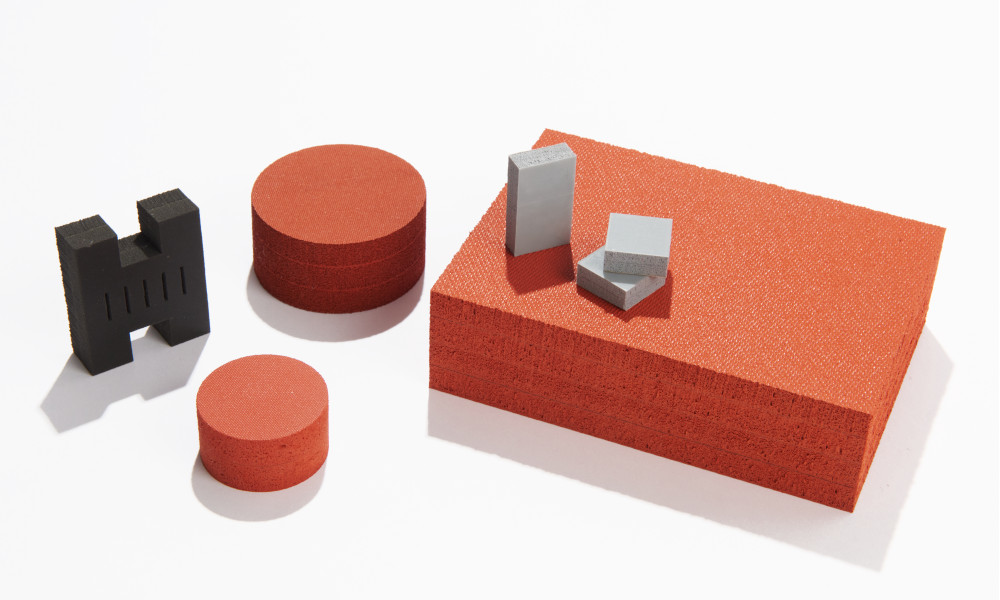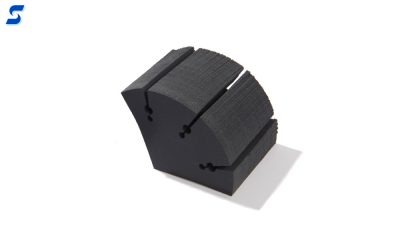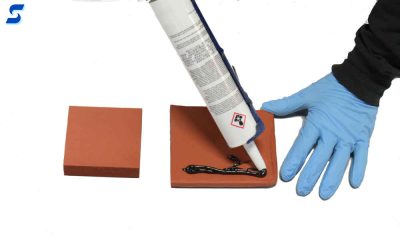Lamination Product
Elastomer Bonding for Developed Thicknesses
Laminated layers of elastomers to meet custom compression, thickness requirements while avoiding vendor MOQs
Laminated layers of elastomers to meet custom compression, thickness requirements while avoiding vendor MOQs

Developed thickness is a term used to describe laminated layers of materials for purpose of creating non-standard custom thicknesses and/or custom composite layer properties. Related terms include:
The bonding of elastomers requires a knowledge of the base material, the chemistry of available bonding agents, and surface preparation, in addition to processing techniques. Elastomer bonding technology is a Stockwell Elastomerics core competency since 1981.
One of the many benefits of working with Stockwell Elastomerics on developed thickness materials is a lower threshold to entry for buyers. While many base material manufacturers can run a custom thickness material, minimum orders are hundreds of yards due to the long production setups and expensive tooling requirements. With its strong inventory position, Stockwell Elastomerics can often turn orders within a few weeks and minimums are as low as 1 square yard. This makes Stockwell Elastomerics the ideal choice for any size orders including prototypes and pilot builds.
 Stockwell Elastomerics sources materials from Saint-Gobain and Rogers BISCO® silicones as well as Rogers PORON® microcellular urethanes, maintaining a large inventory of these materials. These and other materials are converted into gaskets, pads, and related products. The long, ongoing partnership with Rogers Corporation, and other leading material suppliers such as Saint-Gobain, provide access to technical assistance, new product development and insights into the silicone market. Through its focused efforts on silicone, Stockwell Elastomerics has developed considerable in-house expertise with bonding these and other materials. Stockwell Elastomerics will factor in both how the materials bond together but also the holistic customer use function – from the design and theoretical performance to packaging and ease of use for customers’ production assembly processes.
Stockwell Elastomerics sources materials from Saint-Gobain and Rogers BISCO® silicones as well as Rogers PORON® microcellular urethanes, maintaining a large inventory of these materials. These and other materials are converted into gaskets, pads, and related products. The long, ongoing partnership with Rogers Corporation, and other leading material suppliers such as Saint-Gobain, provide access to technical assistance, new product development and insights into the silicone market. Through its focused efforts on silicone, Stockwell Elastomerics has developed considerable in-house expertise with bonding these and other materials. Stockwell Elastomerics will factor in both how the materials bond together but also the holistic customer use function – from the design and theoretical performance to packaging and ease of use for customers’ production assembly processes.
 Through its partnership with 3M and other adhesive providers, Stockwell Elastomerics can join elastomers with heat-activated adhesives, pressure-sensitive (PSA) adhesives, along with other proprietary technologies that are designed for specific conditions. In addition, some elastomers can be bonded with room temperature vulcanizing (RTV) silicones. Materials that are temperature-sensitive, shelf-life sensitive and messy can take up to 24 hours to cure. For customers who require low silicone off-gassing in their own facilities, Stockwell Elastomerics’ ability to leverage low out-gassing materials and post cure developed composites at its Philadelphia manufacturing facility is an advantage. All of this takes the difficulty out of silicone for customers.
Through its partnership with 3M and other adhesive providers, Stockwell Elastomerics can join elastomers with heat-activated adhesives, pressure-sensitive (PSA) adhesives, along with other proprietary technologies that are designed for specific conditions. In addition, some elastomers can be bonded with room temperature vulcanizing (RTV) silicones. Materials that are temperature-sensitive, shelf-life sensitive and messy can take up to 24 hours to cure. For customers who require low silicone off-gassing in their own facilities, Stockwell Elastomerics’ ability to leverage low out-gassing materials and post cure developed composites at its Philadelphia manufacturing facility is an advantage. All of this takes the difficulty out of silicone for customers.
Base elastomer and bonding process selection are important, but materials such as cured silicones have low surface energy and will not normally allow an adhesive to adhere to the base material. To increase the surface energy of these hard-to-bond materials, Stockwell Elastomerics offers proprietary techniques that enable the creation of developed thicknesses or specialized elastomeric composite properties.
Stockwell Elastomerics’ ability to bond elastomers together helps customers solve tough challenges where a single material or a single sheet of material can’t meet all of the application requirements. Further, elastomer bonding also supports value-added services such as die-cutting and waterjet cutting for gasket fabrication.
Contact Us for further assistance with elastomer bonding for developed thicknesses or specialized properties.